Experienced anglers don’t usually expect too much from August. In ancient times the rising Sirius star was associated with thunder storms, mad dogs and bad luck. Modern anglers might associate Sirius and the dog days of August with sultry weather, low water, lack of rising trout…and bad luck! On the other hand, August is a holiday month so at this time many visitors are taking an opportunity to try our waters.
This year was a little different because just at the end of July we had a modest amount of rain to freshen up the drought. In fact as we all know there was very heavy rain further north with associated floods and dramatic pictures on television, but for our catchments on the Welsh border the effect was localised and quite slight.
The Irfon came up a few inches which affected the Wye below Builth for a day and also the Towy had a slight rise. This might have helped Saul Roberts, who reported a 3 pounds sewin from The Baskets at Llandeilo on a Teal and Silver on 31st July. The Baskets is one of those popular night pools, so Llandeilo club members now have access on alternate dates only.
As the Wye fell back again from its little lift on 1st August, PB of Leominster had a salmon, the first from the river for quite a while, while fishing the Rectory Neck. This is an interesting spot just above a big holding pool, where a ridge of rock narrows the Wye dramatically and where even at a low level there is always a pace to the flow. A couple of years ago in the Neck I remember hooking what I guessed was a big fish which just backed downstream shaking its head until finally the hook pulled in the main pool. Another sad story!
Meanwhile JS of Ambt Delden (Netherlands) had some complaints to make about the over-grown nature of a Wild Stream beat, the Lower Llynfi Dulas. I agree that this beat really is a bit too wild these days, particularly at the lower end as the angler tries to move from the campsite section into the open fields, but then finds himself blocked by a deep pool in the river and barbed wire at the side. We should put this one down for some attention during the winter.
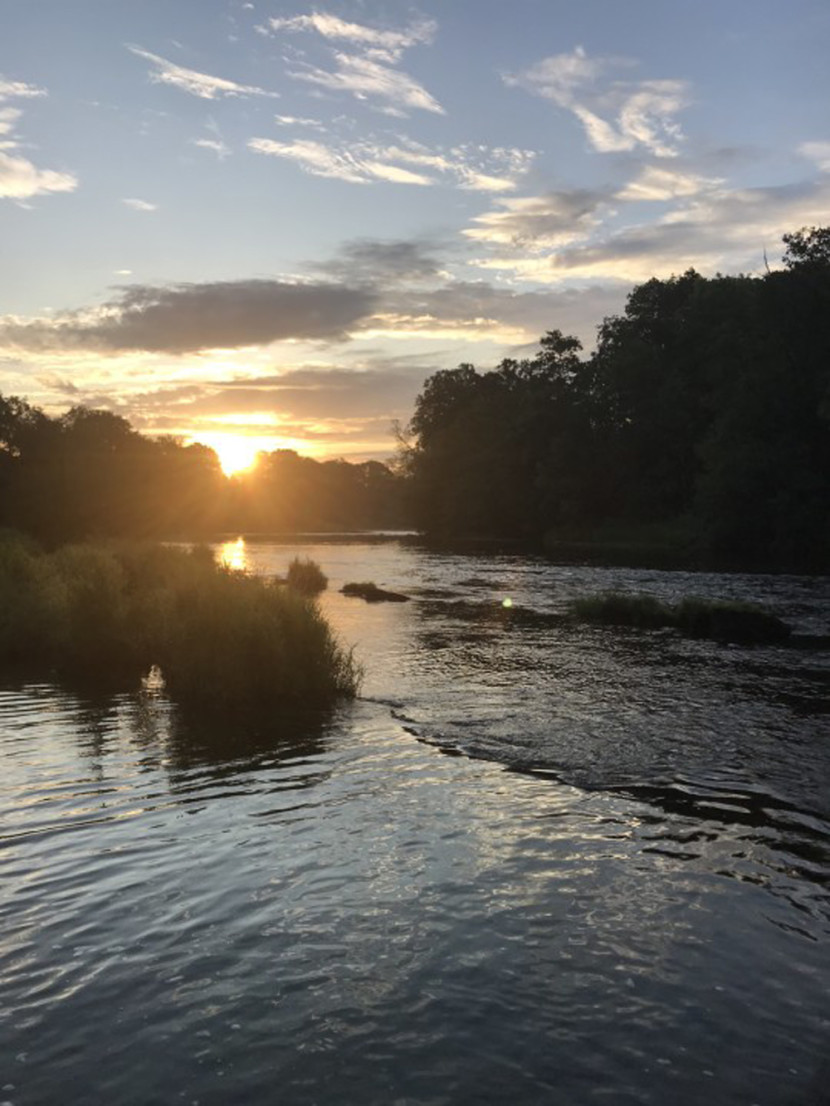 Sunrise at the Rectory (Tim Hughes)
Sunrise at the Rectory (Tim Hughes) 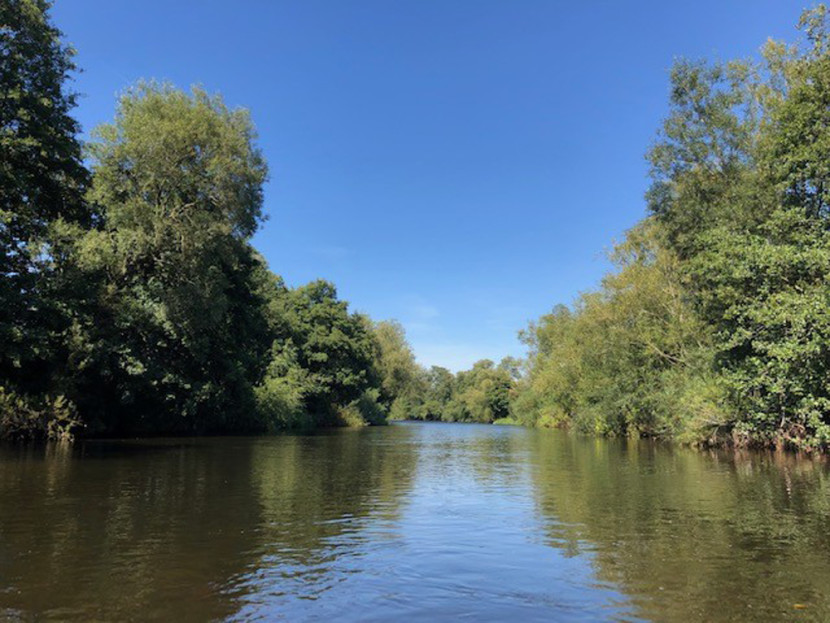 Chainbridge on the Usk (PD from Cheltenham)
Chainbridge on the Usk (PD from Cheltenham) 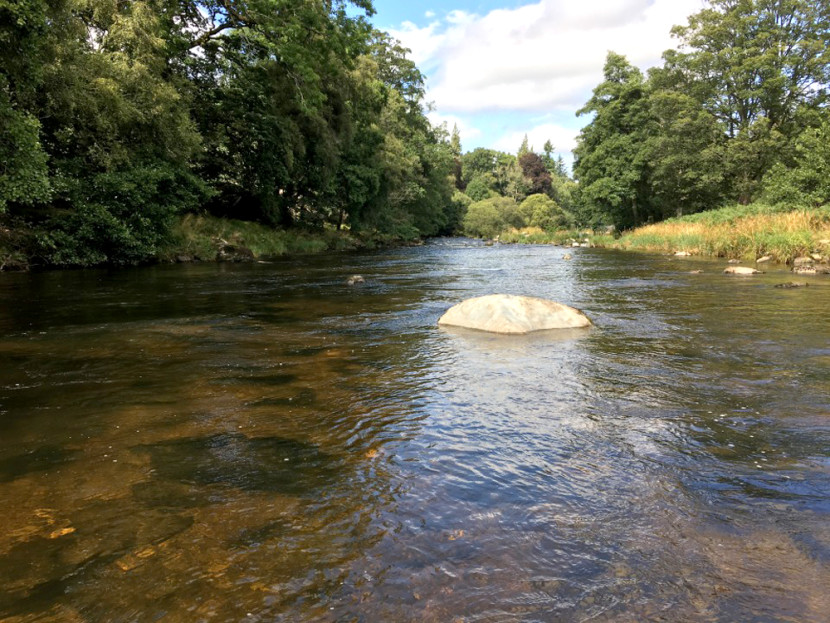 Dolgau (PH from Beaumaris)
Dolgau (PH from Beaumaris) 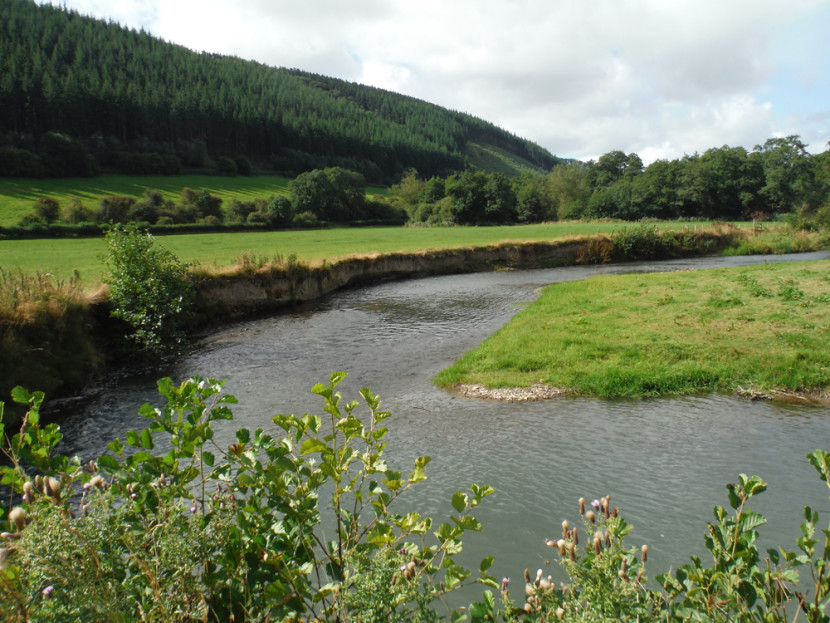 The Lugg at Lyepole
The Lugg at Lyepole On the 2nd GS from Bury St Edmonds reported a dozen trout from the Clettwr gorge taken with a 3 metre Tenkara rod. MN from Bristol fished at Craig Llyn and accounted for 5 trout to 10 inches and also 5 grayling to a very creditable 17 inches. On the following day KL from Bristol managed a dozen trout from Cannop Brook on a Klinkhammer, plus a pair of roach taken on a Pheasant Tail Nymph. Some might find the presence of roach in such a small and rapid brook surprising, but Cannop Ponds, which lie upstream by the stone-cutting works, contain the full range of coarse fish including pike, carp and bream. The occasional roach or even perch finds its way into the deeper pools of the stream below. About then AC from Devon, who was having a quiet day at Ty Newydd, mentioned the gentleman who leaped the fishery gate from the main road and disappeared into the woods with a look of quiet desperation on his face, a toilet roll tucked under his arm. The poor chap probably didn’t realise there is a well-maintained public toilet just down the road at Erwood. And on the 6th news came from the East and West Cleddau in West Wales, where AW from Belper took 13 small trout on the Bont beat.
JS from Tonbridge Wells was not very happy with the Usk’s Dinas beat, where he found a new key operated padlock blocking the access gate, so that he was obliged to reverse his car back up that very steep slope to the main road. Earlier on this spring I found the same gate in such bad repair that it fell off the hinges when you opened it, so I hope all has been put in order now.
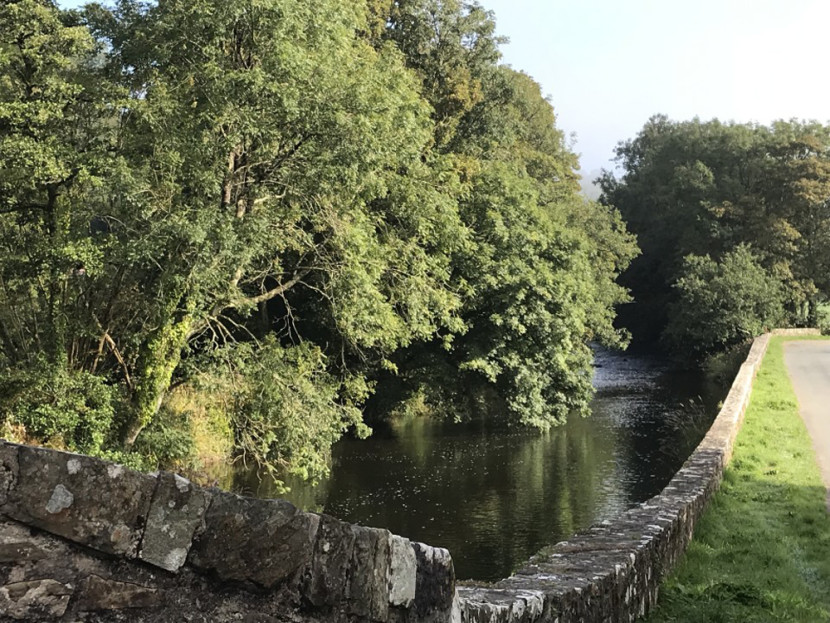 Eastern Cleddau (MW from Pembroke Dock)
Eastern Cleddau (MW from Pembroke Dock) .jpg?w=830) Large brook dun, Llynfi Dulas
Large brook dun, Llynfi Dulas 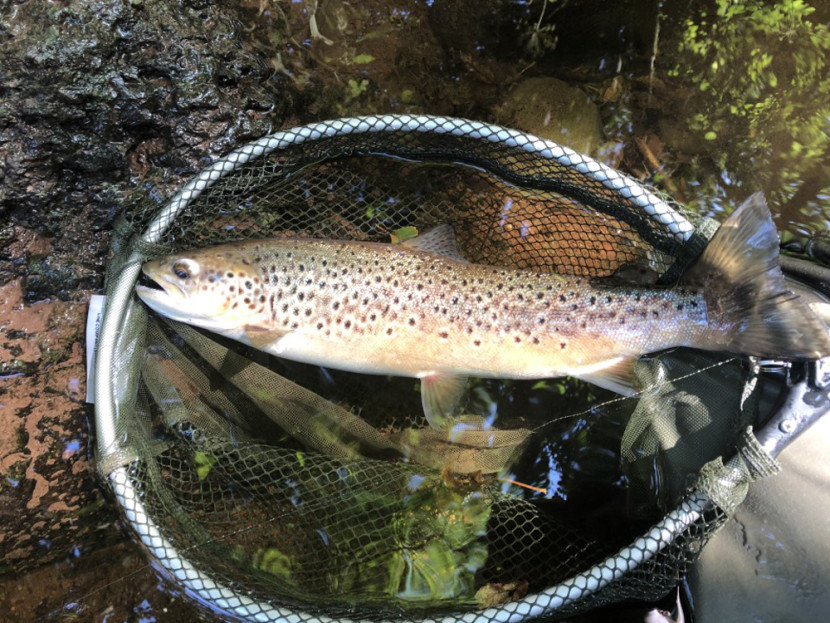 Pantyscallog trout )AP from Dudley)
Pantyscallog trout )AP from Dudley) Dave Collins fished cooler water below the Elan junction again at Craig Llyn on the 8th and reported 8 trout, 2 grayling and a chub. The water then was still extremely low, but at this point the weather changed and powerful gales with associated damage and some heavy showers came in from the west. This was like an equinoctial storm, but experienced in mid-summer. Most of our rivers rose in flood for a couple of days and angling plans had to be changed. Once again my apologies to clients whose trout fishing days were delayed. The flood was not an extensive one, but the fresh water was welcome and a few more salmon were taken from the Wye.
On the 11th AB from London found the Edw at Hergest quite muddy, but managed 16 trout on nymphs. AP of Dudley returned to the Forest’s Cannop Brook, which was also fairly muddy, but took 22 trout and a roach, mostly on the duo, before his day finished with a bit of drama. First thunder and lightning spooked deer which passed him running through the trees, then heavy rain and finally a flash flood in the river. This can happen quite quickly here when the ground is wet as the forest drainage ditches on either side discharge within minutes. On the 13th MN from Bristol caught 10 trout at Cefn Rhosan Fawr on the upper Usk using a size 18 CDC Pale Watery, but was bothered by canoe trespassers who refused to leave the river.
The wild storms of 10th and 11th August seemed to have had more effect in South-West Wales and provoked, for the first time this year, a really good run of sewin and salmon into the Loughor and Towy. At a fishing club meeting at Pontardulais later I saw more smiling faces around the committee room than for many months. Members had been catching by day with the spinner and then later by night with the fly. There were a number of sewin in the 1-3 pound range in the Welsh rivers and some much larger ones also. The theory– and it is only a theory – is that we don’t just have high water levels and high tides to thank for this. During that weekend of gales the nets had necessarily been withdrawn, conditions even in the estuaries making it too dangerous for commercial fishermen to put to sea. Thus fresh fish had a free run for once and anglers reaped their own silver harvest upstream.
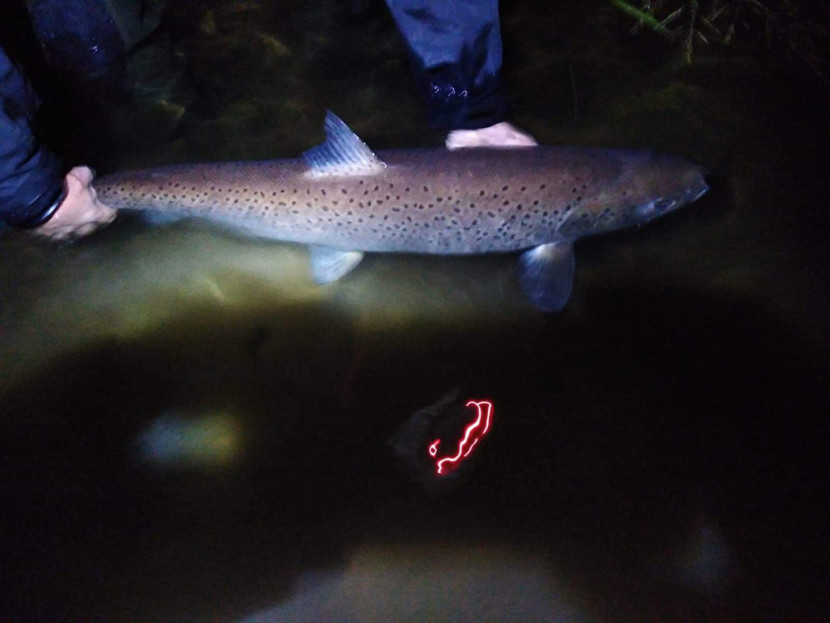 Harvest sewin 31 inches, River Towy (Lyn Williams)
Harvest sewin 31 inches, River Towy (Lyn Williams) On the 15th August, RS of Monmouth fishing the Usk at Glan yr Afon encountered three poachers spinning the river. This is another case in which we would be interested to know what action was taken on the day because the report doesn’t make it clear. DR from Bristol took 8 trout to a very creditable 14 inches on the little Olchon brook, but had complaints to make about barbed wire blocking his route upstream. I believe I had the same problem on my last visit. More rule breakers were reported on the 18th by IG from Pontypridd and two friends who found three poachers spinning on Talybont reservoir. This time, if I read the report correctly, the police were called. Thank you. IG and his group had a 2 pounder amongst their catch of 4 trout.
BP from Leominster fished a French leader at Llandewi where the level of the Ithon was slowly falling, and reported 8 trout from 6-10 inches. On the 20th PC from Frome had a dozen trout to 10 inches from the Hergest beat of the Edw using a CDC and Elk – a sort of general purpose caddis imitation. AR from Portway with his 7 year old daughter Sienna had a great time at Abernant, catching 3 trout and 3 grayling. (My own philosophy with children is that it works very well taking them fishing even at a young age, but they absolutely must catch something quickly to engage the attention. Well done! The young lady looks very pleased with her trout).
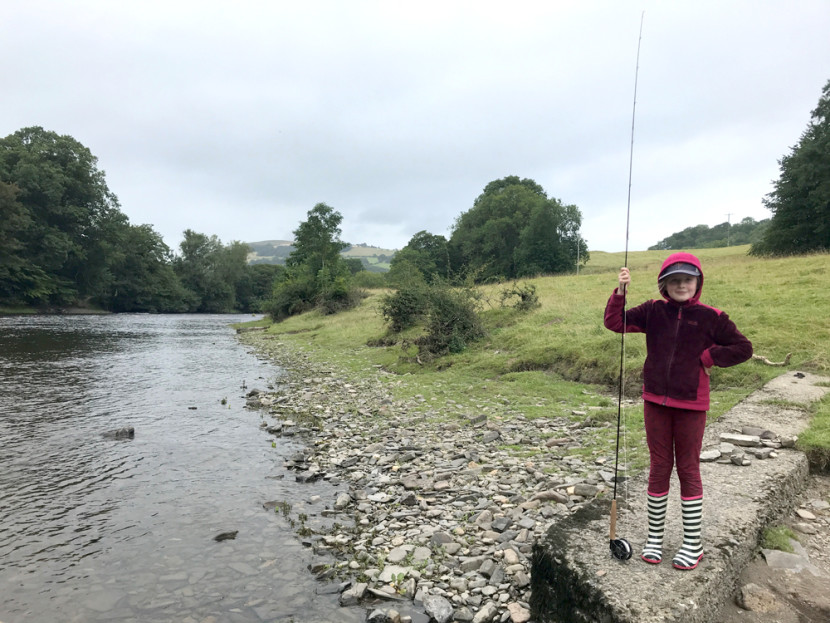 Sienna at Abernant
Sienna at Abernant 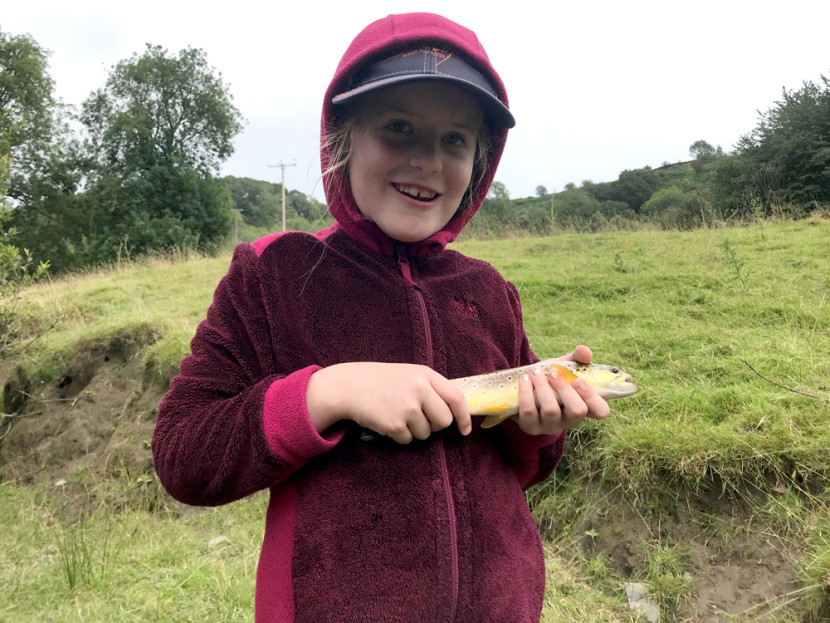 Sienna with Abernant trout
Sienna with Abernant trout On the 22nd RB from Redditch had 14 trout and 2 grayling at the Rectory. JG from Monmouth, parking on the designated spot for the Upper Grwyne Fawr beat, was dismayed to find a notice on his windscreen from a local farm, claiming the parking space. This is just a little patch by the stream which we have been using for 10 years or more. It is also probably used by visitors to the little chapel opposite. Hopefully the WUF will be able to establish the rights of the situation, because there is no obvious alternative.
Meanwhile AT (no home town given) fished the Lugg at Pilleth for a couple of trout and described it as very overgrown. I’m loathe to challenge AT’s opinion, but you should have seen the state it was in last year! I was one of the team which pruned the Pilleth beat at the end of this winter and I can promise that it was in fair condition when the 2019 season opened. It’s a tight little stream and will surely require an annual pruning visit, but it does hold plenty of trout. MR from Winchester had 8 trout and 5 grayling from Ty Newydd on the 23rd and the following day JA of Leominster recorded 11 trout from the Edw at Hundred House.
The late August bank holiday did bring a proper heat-wave, another record one in fact, but this time there was some water still in the rivers to compensate. JD from London had a 2 pounder in a brace taken fishing a dry fly during the evening at Ashford House and noticed how many excellent trout there are roaming that beat. AP from Wirrall nearly had a nasty accident while fishing the Arrow at Kington. This apparently happened while trying to work his way upstream past the weir by the turkey farm, and involved a metal grid collapsing under him. This is always a difficult place. If I remember correctly, the only practical way is to abandon the river for a few yards, head uphill on the track as if going into the turkey farm, then take the gate into the first field on the right and then the gate into the wood on the other side and so reach the river again above the weir.
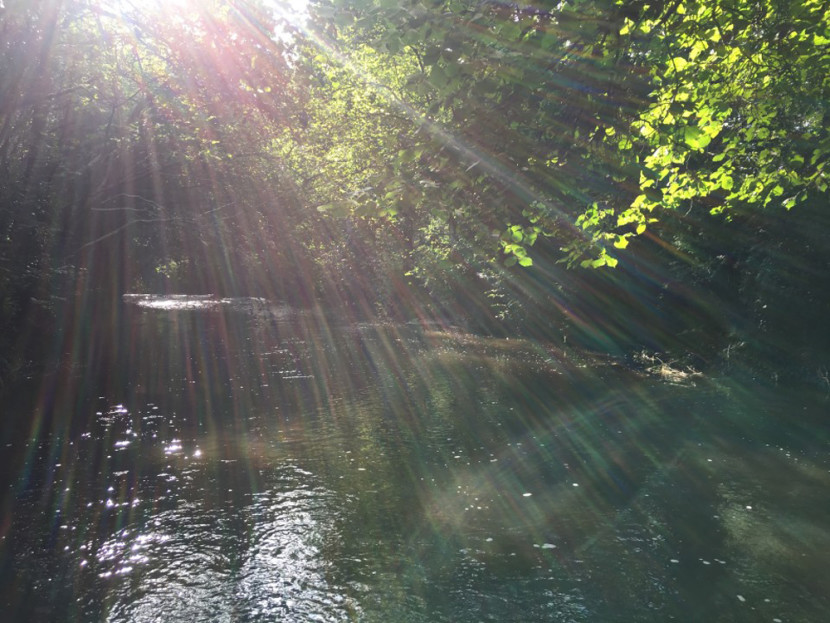 Evening on Mowley Wood (DG from Herefordshire)
Evening on Mowley Wood (DG from Herefordshire) On the 25th MR from Winchester was out on Ashford House with guide Chris Price and managed 13 trout. MR was another with complaints to make about access on this beat. On the 29th DA from Brecon fished Llyn Egnant for one trout and had this to remark about the conditions he found up there: “Weather forecast mainly dry with light winds, so Egnant had occasional gales with driving winds.” It’s amazing the difference a few hundred feet of altitude can make to the weather. Summer or not, for the hills take all the warm clothes and wet gear you might need! On the final day of the month JA from Leominster took 10 trout from the upper Lugg at Litton using a Parachute Adams.
Some of us have been watching the recent disagreements concerning the General Licence for shooting pest birds with considerable interest. English Nature, the RSPB, Wild Justice, the EA and the BASC have all been involved in disagreement over the general principles involved, and at times in some quarters the squabble has deteriorated into a deplorably personal one. It seems that is becoming the nature of politics in our country today; reasoned debate and a polite approach to those who disagree with you is rather out of fashion. The Angling Trust, I was glad to see, declared support for farming interests and the BASC, and is also arguing for fish-eating birds to be put on the General Licence so that their numbers can be controlled in a meaningful way – which certainly isn’t the case at the moment.
Which leads me on to the subject of fish-eating predators in general and in particular the one which somehow bothers me the most, the cormorant. I never yet met an angler who had a good word for cormorants although many of the other predators we can somehow find room for. The otter, we like to think, takes mainly eels or sick fish, and in any case he charms us with his playing. I have had a good sea trout take a fly within seconds of an otter’s trip through the darkened pool. The little kingfisher is mainly after minnows, and his redemption is that electric blue flash along the watercourse which brightens our day. The heron also takes mostly small fish and eels, while his hunting method is interesting to watch and we have become used to his angular pterodactyl shape in flight against the sky and his harsh croak overhead. At the same time, he has gradually become used to us. When I was a boy I used to try stalking one in the riverside marshes for amusement and it was very difficult to get close. Nowadays the heron is reasonably easy in our company, and seems to feel safe enough, sometimes within yards. But the sinister cormorant, along with the two saw-billed ducks, is a difficult creature for any of us to love. Again, when I was a child, a cormorant was never seen on inland waters and it was a rare enough sight on the coast. Now he hangs around our fisheries, sometimes in gangs, winter and summer. He can kill and swallow a trout or grayling of 2 pounds, and do it again the next day. Alternatively he can fill his stomach with trout and salmon parr by the dozen. What is worse, he injures more than he kills, with vicious stabs of that deadly beak. The most efficient of hunters, he has a habit of attacking from below and it’s common enough to find a live fish almost disembowelled by the cormorant beak. I would say that the average large grayling on the upper Wye bears at least one cormorant scar, evidence of a narrow escape.
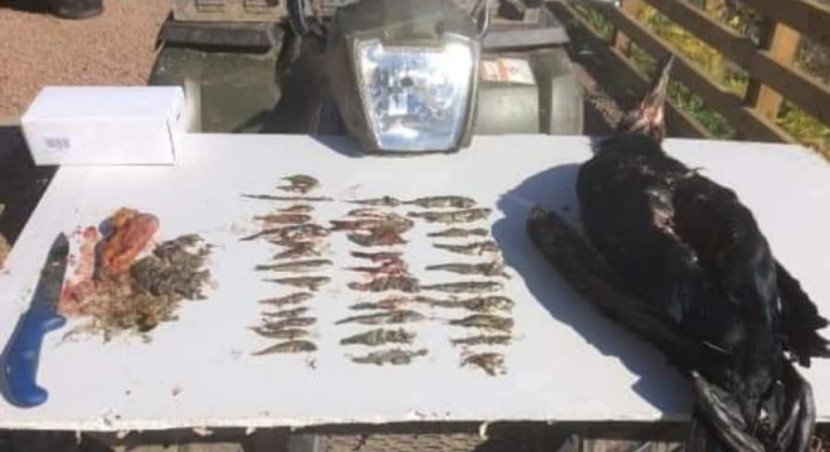 Cormorant autopsy
Cormorant autopsy All of the above made it especially irksome to be reminded of the destructive creature on every visit to the UK’s Defence Academy at Shrivenham. Life isn’t all fishing, you know, although it ought to be. The largest part of the Academy is the Joint Services Command and Staff College, which I supported over 12 years. The College is a fascinating place with an international reputation attended by some very impressive students selected to go on with their military careers, usually lieutenant-colonels, wing commanders, naval commanders and equivalent ranks from many countries apart from the UK. The average age is about 40 and these are bright people at the top of their game. As an elderly humanitarian adviser I might find myself seated between a Typhoon pilot and a naval officer who has just received a telegram giving him command of a destroyer as his next job. Already very good at one thing, they are now learning be part of a team planning very complex international and inter-service operations. Over coffee, you might meet such interesting people as a Columbian pilot who has for years flown jungle missions against FARC, a senior French fire officer resplendent in the uniform of Les Pompiers, a member of the Israeli Defence Force or an officer from the Red Army of China. But here I had better stop, not wishing to find myself on the wrong side of the Official Secrets Act.
My point is that if you didn’t know it already you will doubtless be thrilled to learn that the mascot creature of the College is the cormorant. The cormorant symbol is everywhere. You come across the bird modelled in brass in the imposing basilica-style entrance hall with its wonderful collection of old regimental paintings, and the main lecture theatre is named “Cormorant Hall.” There is even a “Shag’s Bar” for those who want to avoid the suit and tie formality of mess dining. The cormorant was supposedly chosen because it flies, swims and nests on land, while the college deals with the education of military forces to operate by air, land and sea. I suppose the selection of the cormorant’s qualities – presumably a tendency to be cunning, lethal, but also wary and generally hard to kill - might be a good one for emulation by mid-career military officers training for higher command, but it can’t be expected to please an angler!
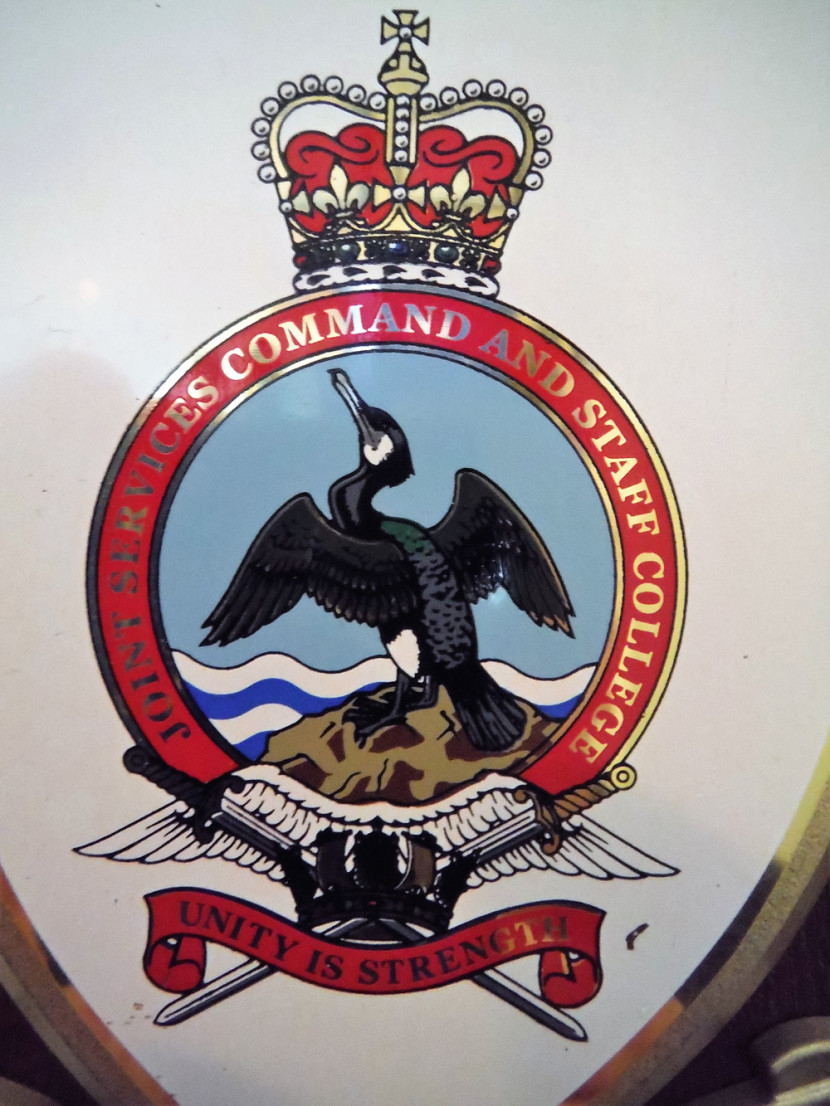 Joint Services Command and Staff College - the emblem
Joint Services Command and Staff College - the emblem It was a renewed pleasure to watch the latest round of the Bob Mortimer and Paul Whitehouse fishing programme on BBC 2 this month. So many people seem to enjoy these. This time the pair were fishing at Glanusk Park and stayed in a cottage somewhere in the nearby hills. It looks as though it were filmed in September and our two heroes are shown fly fishing with the Usk running full and slightly peat-stained. Conditions seem good and the pools are familiar enough, first in one of the runs above the bridge and later down by Solomon’s Seat where a salmon showed by the corner – just as a salmon always seems to show there. It’s a little difficult to put a finger on exactly why this series is so universally attractive.
The photography, making much use of drones, is certainly gorgeous, nearly as good as the old Passion for Angling series. On the other hand, purple passages of commentary are thankfully avoided. There is nothing very technical about fishing to trouble the viewer and in fact nobody seems to fish particularly well or with outstanding success. This matters not at all. Instead, the two veteran comedians strike gentle sparks off each other with their wry take on life in general, middle age and ill health, wives and children, memories of their parents and the girls they first kissed. Whitehouse is trying harder than Mortimer regarding the fishing, but you could really summarise it as messing about in the river with a cooked picnic at lunchtime for good measure. This time it was lamb and mint yoghurt with salad in pita bread. Lightweight viewing, I suppose, but it’s all a great pleasure. Somebody gave me their book the other day and that also produced a smile.
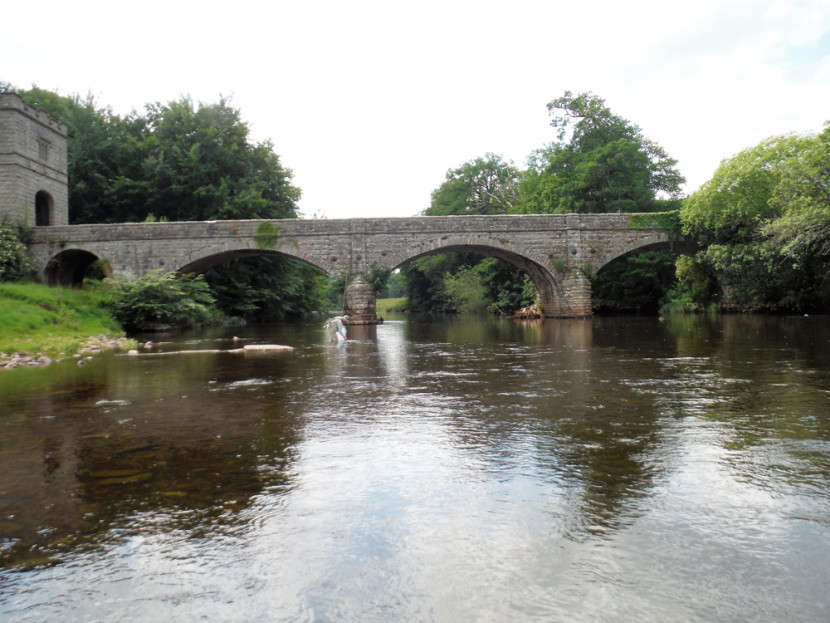 Glanusk Estate
Glanusk Estate Because I suppose that August counts as the silly season, quite a lot of last month’s reporters had complaints to make about canoeists, inconsiderate throwers of sticks, wild swimmers, dogs romping in the water near anglers and all the rest of the summer circus. Never mind, because it’s more or less over now and we have the autumn to look forward to. Already there is a sharpness to the early morning air and dew in the grass to show footprints. September and October can be glorious grayling months. Tight lines!
Oliver Burch
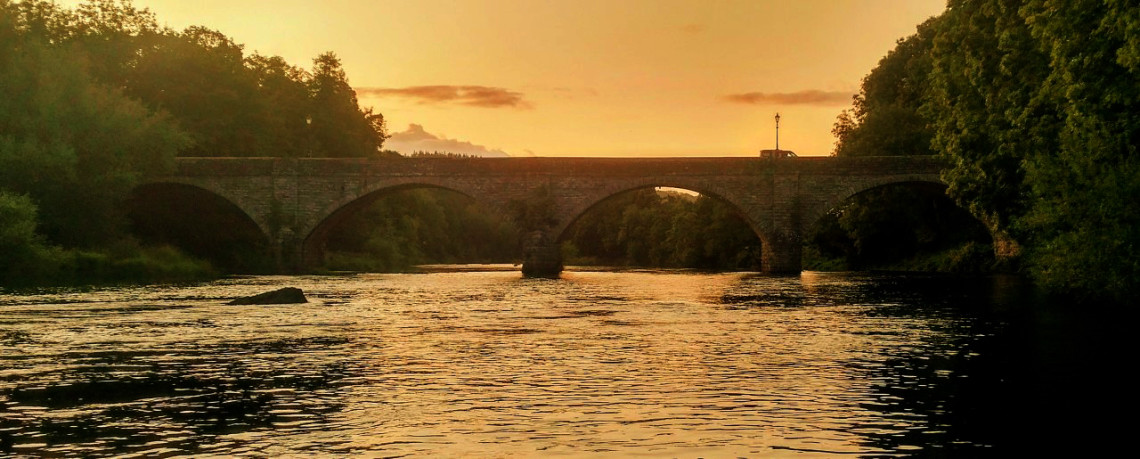 End of the day at Boughrood Bridge (JM from Bristol)
End of the day at Boughrood Bridge (JM from Bristol)